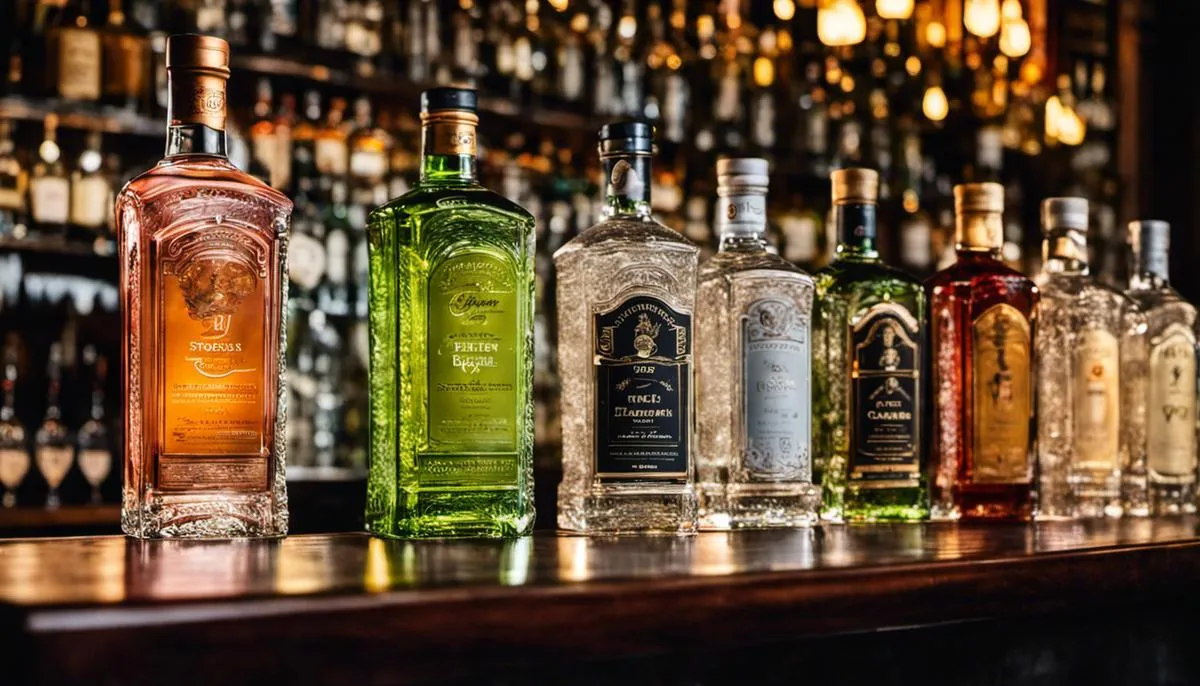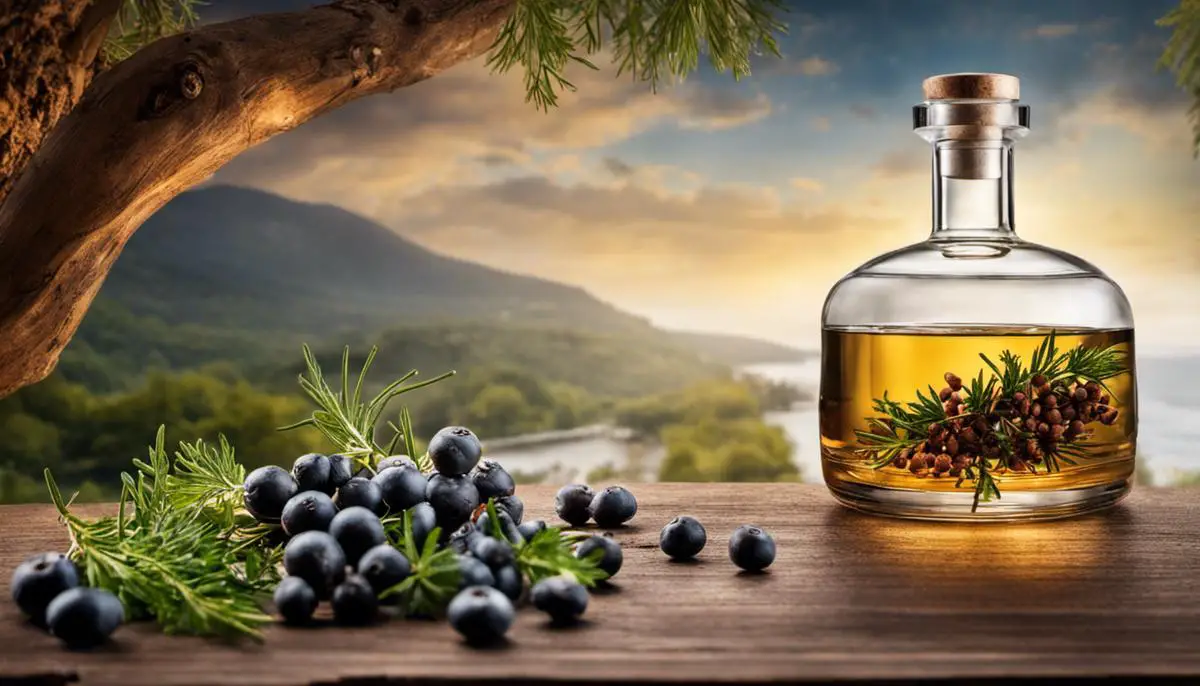Welcome to the enigmatic world of gin, a drink treasured since time immemorial. Now synonymous with artisanal craftsmanship and diverse botanical infusions, gin presents a flavor symphony waiting to be discovered by the discerning palate. Deftly navigating from its rich history to the art of gin tasting, this exploration will equip you not only with understanding the essence of this sophisticated spirit, but also guide you in savoring different gins like a connoisseur. So whether you’re a gin novice or a seasoned spirit enthusiast, let’s embark on this journey to demystify gin and enhance your appreciation for one of the world’s most versatile spirits.
Understanding Gin
The Intriguing World of Gin
Gin, a distilled alcoholic beverage, is known for its dominant flavor derived from juniper berries. Its storied origins are traced back to the Middle Ages, primarily in Holland, where it was initially used for medicinal purposes due to its herbal properties. By the 17th century, gin consumption became more commonplace and it grew into the popular spirit we know today. The distillation process involves redistilling neutral grain alcohol with botanicals, with the juniper berry being the most prominent. Other botanicals often include coriander, angelica root, lemon and orange peel, anise, and licorice, among others.
Types of Gin and Base Ingredients
Gin types differ mainly in their manufacturing process and the varying recipes of botanicals. The most prevalent styles are London Dry, Old Tom, Plymouth, and Dutch or Genever. For instance, London Dry is characterized by a strong juniper flavor and is made mostly through the distillation method. It gets its name not from where it is produced, but from the process used to make it.
On the other hand, Old Tom is slightly sweeter and was popular in the 18th-century England. Plymouth, named after the city in southwest England, carries a strong hint of juniper, but is less dry than the London category. Lastly, Genever, the original style of gin, is maltier due to its base of malt grain mash, much like whiskey.
Appreciating the Gin Tasting Experience
Understanding the distinct nuances of gin varieties helps in enhancing the tasting experience. Nose the gin by taking a gentle sniff to catch a scent of the distinctive aromatic botanicals. The ‘neat tasting technique’ is followed by sipping a small amount to identify the gin’s character. The initial taste or the ‘fore’ usually gives off a potent alcohol flavor, after which the ‘middle or heart’ presents the ensemble of botanical tastes. The follow-up taste, or the ‘finish’, usually leaves tones of citrus or spice.
While juniper is typically the star player, the other botanicals present greatly influence the gin’s taste profile. Key elements to look for include the aromatic intensity, sweetness, bitterness, and smoothness. These components help distinguish one gin from another and allow the taster to appreciate the uniqueness that each bottle brings. When it comes to pairing gin with food, consider matching the botanicals in the gin with similar flavors in the food for a symphonic dining experience.
The Magic of Botanicals in Gin
Botanicals are the heart of gin – they shape the taste, aroma, and uniqueness of every variety. Although the flavor of juniper must always lead, skilled distillers ingeniously mix other botanicals to create exclusive versions of gin. These can include herbs, spices, fruit peels, and flower petals. It’s incredible how adjusting the ratios of these botanicals can turn a regular gin into an extraordinary spirit brimming with intricate flavor profiles.
Grasping the basics of gin production, the different categories, key ingredients, tasting methods, and the impact of botanicals is vital to fully appreciate and enjoy this complex drink. This broader understanding enriches the tasting journey, allowing enthusiasts to detect the nuances that make each gin distinctive.

Gin Tasting Basics
Decoding the Flavor Profile of Gin
A gin’s profile refers to the intricate fusion of tastes, scents, textures, and after-tastes it displays. Every gin has a unique flavor profile, fundamentally based on the chosen mix and proportion of botanicals during distillation. For instance, some gins might exhibit a prevailing citrus taste, while others might be overflowing with spicy or floral undertones.
The Importance of Smelling
The sense of smell plays a critical role in the gin tasting process. Before tasting the spirit, it is recommended to smell it first. This action triggers neural responses in the brain’s olfactory bulb responsible for perception of flavors. Carefully sniffing a glass of gin serves to prime the palate for the flavors it’s about to encounter.
However, smelling gin requires a particular technique to prevent the alcohol from overwhelming your nose, which can numb your senses to the subtler aromas. To properly smell gin, avoid sticking your nose directly into the glass. Instead, gently waft the gin’s scent towards your nose, or keep your mouth slightly open while smelling to balance the impact of the aroma.
The Art of Tasting
When tasting gin, it’s not enough to simply take a sip and swallow. Instead, take a small sip and roll it around your mouth. This step ensures the gin reaches all your taste buds and reveals its full spectrum of flavors. From the initial taste, also known as the ‘top note’, through to the ‘body’ of the flavor and finally the ‘finish’ or ‘exit’ flavor, every sip of gin has a journey worth savoring.
In general, a well-made gin will have a smooth profile with no harsh flavors or intense burn. It should feel harmonious, with a consistent, rounded balance between sweetness, bitterness, and dryness.
Spotting the Differences in Texture
Texture is another fundamental aspect of the gin tasting experience. A gin’s texture, which can be creamy, oily, or watery among others, is determined by factors such as the distillation process, the particular botanicals used, and the dilution of the spirit. It adds another layer of complexity to the gin’s overall sensory experience.
Understanding these textures can help distinguish between different styles of gin. For instance, London Dry gins may feel drier and crisper on the palate, while Old Tom gins often have a sweeter, more viscous feel.
Crafting Your Own Gin Flavor Profile Dictionary
Embarking on a gin tasting journey can be an enlightening experience. A valuable tool to assist you on this expedition is maintaining a gin flavor profile dictionary. By diligently jotting down your individual experiences and perceptions of different gins, from their aroma and taste to their texture and aftertaste, you create a handy personal reference. This recorded chronicle, over time, becomes a resource for identifying trends and tastes, exponentially improving your gin tasting prowess.
Keep in mind, there are no definitive rules when it comes to gin tasting. Every observation and preference is purely personal, there’s no right or wrong. As your flavor profile dictionary evolves, it allows for a deeper appreciation of the vast array of flavors and styles that the gin landscape provides.

Common Gin Tasting Notes and Flavors
The Role of Juniper in Gin
When tasting gin, the leading note that hits the palate is the quintessential juniper. This is not by coincidence, but by law, which decrees that for a spirit to be classified as gin, it needs a predominant juniper flavor. Contrary to their name, juniper berries are indeed cones from the juniper plant that infuse a gin with a resinous, pine-like taste with a fruity undertone. The gin derives its multifaceted flavor profile from the over 100 organic compounds present in these juniper “berries”. Thus, different species of juniper plants can deliver diverse flavors and notes in gin, from sweet and citrusy to crisp and herbal.
Citrus Notes in Gin
Citrus is another crucial flavor note in many gins, thanks to the peels of fruits like lemons, oranges, or grapefruits used in the distillation process. These citrusy notes typically provide a refreshing, lively character, either balancing out the deeper woody notes from juniper or enhancing the gin’s overall brightness. Each type of citrus contributes differently: lemon often offers a zesty, tangy note, while orange can be sweet or bitter, and grapefruit lends a pleasing bittersweet character.
Floral and Herbal Notes in Gin
Many gins have floral and herbal notes as a part of their flavor profile. Floral gins might include ingredients like lavender or chamomile, which bestow a delicate, aromatic, and often sweet flavor. Herbal gins, on the other hand, commonly incorporate ingredients like rosemary, sage, or basil, adding a green, fresh, or even savory dimension to the flavor.
Spice Notes in Gin
Certain gins involve the use of spices during their distillation process, lending warm and complex notes to the gin’s flavor profile. The spices could range from sweet, like cinnamon, to hot, like pepper, or aromatic, like cardamom. The gin might also feature an exotic blend of spices like coriander, which imparts a citrusy, nutty taste.
Exploring the Earthy and Woody Tasting Notes in Gin
Some gins may present earthy and woody notes, which may come from botanicals such as orris root, angelica root, or even different types of wood in case the gin is aged. These flavors can range from deep and rich to subtle and soft, often providing a grounding contrast to any lighter, more volatile flavors.
Common Finish in Gin
The finish is the taste that lingers after swallowing. In gin, this could be a continuation of the flavors experienced initially or offer new ones not previously detected. The finish could be dry, sweet, or bitter, and it might display a variety of flavors from juniper to citrus, floral to herbal, or even earthy to spicy. The duration it lasts can also vary greatly, sometimes ending almost immediately, while other times it may linger, allowing the flavors to evolve on the palate.
If you are interested in exploring the diverse world of gins, prepare yourself for a thrilling journey of flavor exploration. The variety of gin options is seemingly limitless, each boasting its own unique flavor profile and tasting notes. The secret to unraveling these intricate tastes is to allow yourself the pleasure of tasting, comparing, and ultimately enjoying a wide range of different gins.

Pairing Gin with Food
Demystifying the Flavor Profile of Gin
Before delving into the fascinating world of flavor pairings, it’s worth gaining a sound understanding of gin’s core flavor profile. The signature tone of gin comes from the potent flavor of juniper berries, providing a piney and refreshingly crisp taste. Other commonly used botanical elements like the spice of coriander, the earthiness of angelica root, and the zing of citrus peels add layers of complexity. Differing gins might place more emphasis on these additional botanical inclusions, resulting in unique flavor profiles that can range from floral, to spicy, to citrusy, or even herbal.
Pairing Gin with Cheese
Gin’s bright, aromatic flavors make it an excellent pairing for cheese. In general, robust, flavorful cheeses are a good match for gin. For instance, a Dry Gin with its juniper-forward flavor can be paired nicely with an oily, rich cheese such as Manchego or Gouda. A floral Gin, with notes of lavender and rose petal, could be complemented by a creamy Brie or Camembert, allowing the gin’s delicate botanicals to shine without being overpowered.
Giving Main Courses a Gin Companion
When it comes to main courses, the herbs used in preparation should guide the choice of gin. A crisp London Dry Gin with its sturdy juniper foundation is fantastic alongside dishes that feature rosemary, sage, and thyme. Fish dishes, which are often light and delicate, pair well with a nuanced floral gin – the gentle botanicals won’t overpower the meal and can actually enhance the taste of the seafood. On the other hand, an Old Tom Gin with its sweeter profile pairs perfectly with spicy foods, helping to balance and mellow the heat.
Accentuating Dessert with Gin
Gin and dessert may seem like unusual companions, but there’s a surprising number of pairs that work beautifully together. Consider the citrusy brightness of a traditional Dry Gin alongside a tart lemon tart or lemon-poppyseed cake – the gin’s acidity complements the dessert’s tang. For a richer, more decadent dessert, such as a dark chocolate torte, an aged gin with notes of vanilla and spice can be a wonderful counterpoint, enhancing the complexity of the cocoa while adding its own layer of intrigue.
Playing with Gin in Food Preparations
Gin can also actively be used in food preparations, not just as an accompaniment. For example, gin-cured salmon takes on the flavors of the spirit, including its juniper and fruit notes, enhancing the richness of the fish. Similarly, desserts can be adorned with a gin-infused cream or a gin and tonic sorbet to lend a surprising twist and an added depth of flavor.
Embarking on a Gin Tasting Journey
Gin tasting and food pairing can be a highly personal and dynamic experience which is heavily dependent on individual taste preferences. View the provided recommendations as merely an introduction to the world of gin. Don’t hesitate to mix and match different foods with your gin to discover novel combinations that could potentially enhance your dining experience and give a new layer of complexity to your gin tasting journey.

Understanding and Rating Premium Gins
Exploring the World of Premium Gin
Superior gins, often known as premium gins, are a diverse group of spirits primarily produced from juniper berries. These standout gins are characterized by their high-quality botanicals, meticulous distilling processes, and captivating brand stories, which set them apart from ordinary gins. A high degree of artistry is seen in their crafting process where unique distilling techniques, such as pot or vacuum distillation, are used. The result is a remarkable sensory experience. Premium gins typically showcase intricate and extravagant tasting notes, echoing their top-tier status.
Key Characteristics of Premium Gins
Understanding the key characteristics of premium gins involves delving into their essential components and production processes. Premium gins are typically full-bodied with a clear and pronounced juniper flavor. They often bring a harmonious balance of botanical flavors, such as coriander, angelica, citrus peels, and many other herbs and spices. Additionally, their ABV (alcohol by volume) content is usually higher, around 45-50%, amplifying their taste and character.
Deciphering Gin Tasting Notes
Deciphering gin tasting notes can be complex as it is dependent on a variety of factors such as the proportion and type of botanicals used, the distillation process, and even the water source used for dilution. Generally, these tasting notes can be broken down into three key areas: smell (nose), taste (palate) and finish. The nose refers to the initial scent you get from the gin before tasting. Premium gins often have a powerful, aromatic nose with a perfect array of botanical scents that are not overly alcohol-heavy.
On the palate, premium gins feel rich, rounded, and delicate. Their texture often reflects their high-quality natural ingredients, providing a mouth-feel that is luxuriously smooth and balanced. The finish, or the taste that lingers after swallowing, is clean, crisp, and usually long-lasting.
Rating Premium Gin
Rating premium gin entails considering several quality indicators. Taste, packaging, brand story and price are just some of the many factors that are taken into account. The gin’s flavor – from its unique blend of botanicals – is paramount, with judges looking for a balance between the juniper and the other herbs and spices. Packaging, on the other hand, is important to the extent that it communicates the brand’s message, authenticity, and quality. Finally, the price is weighed against the gin’s overall quality to determine if it offers good value.
Premium Gins To Try
For those interested in experiencing premium gins, there are many options available. For instance, The Botanist Islay Dry Gin from Scotland highlights 22 local botanicals, offering a taste that is rich and mellow. Another option is Monkey 47, a German gin with 47 different botanicals, resulting in a complex yet well-balanced flavor profile. Whichever brand you opt for, you’re in for a uniquely indulgent experience that truly exemplifies the intricacies of gin appreciation.

And thus, we close our journey through the captivating world of gin. The knowledge and insights gleaned from this exploration should enable you to discern the subtle nuances in the taste, aroma and texture of various gins and make informed choices in your future tasting endeavors. Whether you’re indulging in a gourmet meal paired with a carefully selected gin or assessing the quality of premium gins, you now carry the wisdom to appreciate each sip to its utmost. Here’s raising a toast to your well-rounded gin journey, and may your exploration continue to invite exciting revelations in the sprawling universe of this charismatic spirit.





